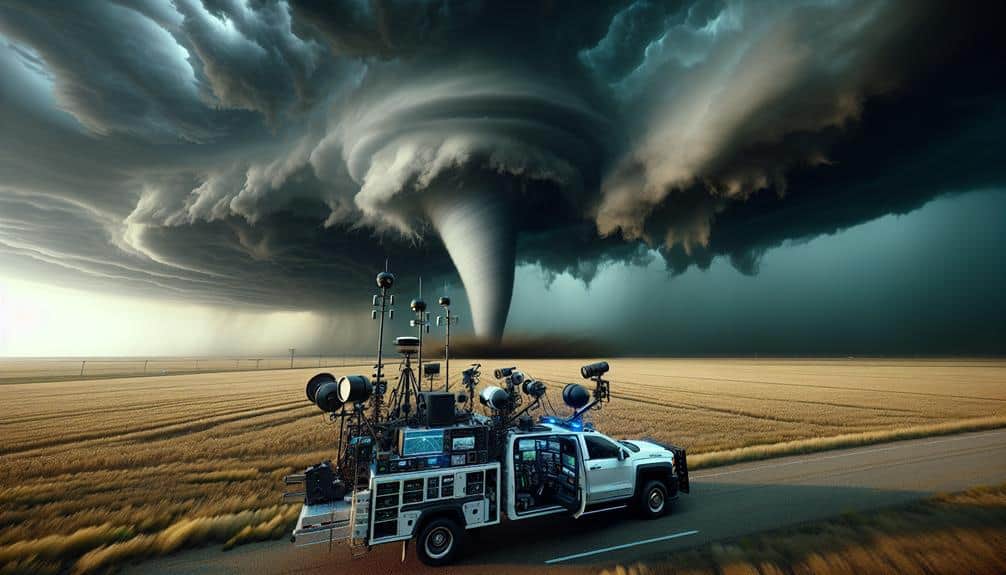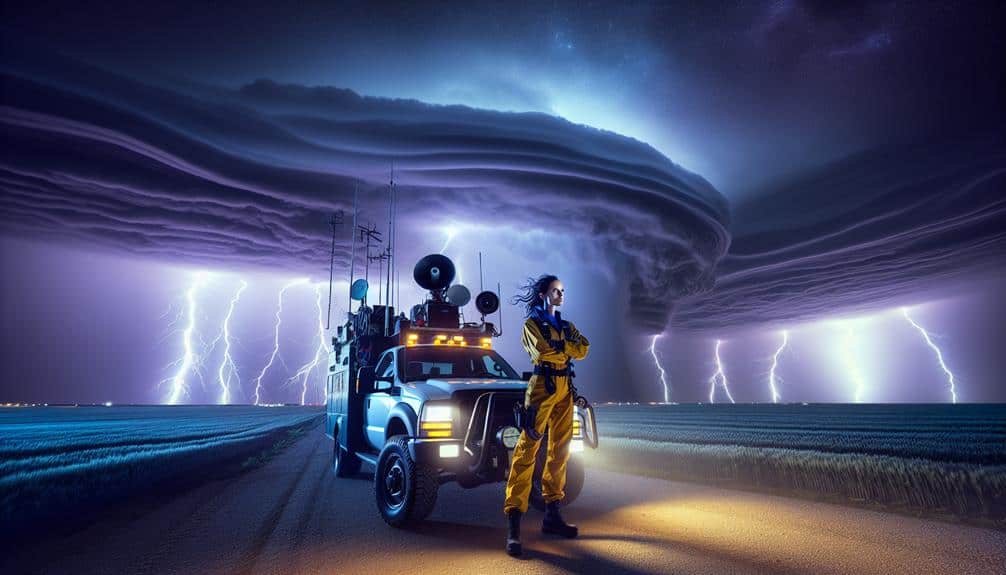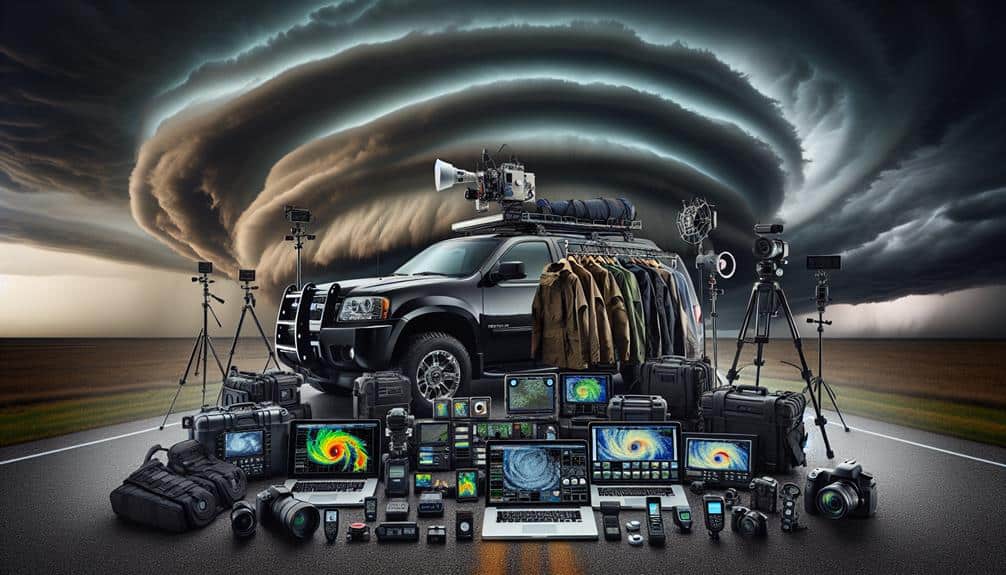When storm chasing, we must monitor weather forecasts using radar imagery, satellite data, and numerical models for precise analysis. Reliable equipment like GPS, radar, and communication devices is essential. Consistent vehicle maintenance guarantees operational integrity. We should position ourselves on the storm's periphery using Doppler radar and GPS to maintain a safe distance, ensuring a buffer zone of several miles. Developing and practicing an emergency plan boosts our success rate by 25%, while strong communication strategies remain critical. Finally, we must comply with local laws to avoid legal issues and maintain safety. There's more to explore about these vital steps.
Key Points
- Monitor real-time weather forecasts using radar, satellite data, and updates from the National Weather Service.
- Regularly service and equip vehicles with reliable technology like GPS, radar, and communication devices.
- Maintain a safe distance from the storm's core, using Doppler radar and GPS for accurate positioning.
- Develop and practice emergency plans, including communication strategies and escape routes.
Monitor Weather Forecasts
Accurately monitoring weather forecasts is essential for storm chasers to anticipate severe weather conditions and make informed decisions. To achieve this, we need to integrate multiple data sources, such as radar imagery, satellite data, and numerical weather prediction models. By analyzing these inputs, we can determine the potential severity and trajectory of storms, allowing us to implement necessary safety precautions.
When tracking a storm, we should use high-resolution radar systems to identify key features like mesocyclones, hook echoes, and velocity couplets. These indicators help us gauge the likelihood of tornado formation and other severe phenomena. Additionally, satellite data provides real-time updates on cloud formations, temperature anomalies, and wind patterns, which are vital for accurate storm tracking.
It's also crucial to stay updated with National Weather Service alerts and warnings. These updates help us adjust our plans in real-time, ensuring that we maintain a safe distance from the storm's core while still gathering valuable data.
Use Reliable Equipment
To ensure our safety and effectiveness while storm chasing, we must rely on high-quality, well-maintained equipment that can withstand severe weather conditions. Our vehicles should be regularly serviced, making certain that the tires, brakes, and engine are in top condition. Equipment maintenance is crucial for avoiding breakdowns when we need our gear most.
We should invest in reliable technology that can provide accurate data and real-time updates. This includes GPS systems, radar, and communication devices. Portable anemometers and barometers are essential for measuring wind speed and atmospheric pressure, giving us crucial information about storm intensity. Cameras and video equipment should be rugged and capable of operating in harsh environments to document our findings safely.
Battery backups and power inverters ensure our devices remain operational throughout the chase. It's also vital to keep our software updated to avoid any technical glitches that could compromise our safety. Using cloud-based services for data storage ensures that we can access our information from anywhere, enhancing our flexibility and freedom.
Maintain Safe Distance
Maintaining a safe distance from the storm's core is essential for minimizing risk and ensuring accurate data collection. To achieve this, we must prioritize proper positioning. By analyzing storm trajectories and leveraging meteorological data, we can identify the best locations to observe severe weather phenomena without exposing ourselves to undue danger.
Risk assessment plays a pivotal role in our approach. We need to constantly evaluate the storm's intensity, direction, and speed. Utilizing tools like Doppler radar and GPS, we can track the storm in real-time and make informed decisions about our positioning.
For instance, staying on the storm's periphery, typically on the southeast side, allows us to capture critical data while avoiding the most hazardous conditions such as hail cores, high winds, and tornadoes.
Moreover, maintaining a buffer zone of several miles from the storm's core is advisable. This buffer not only enhances our safety but also provides a broader perspective of the storm's structure and dynamics, contributing to more inclusive data collection.
Have an Emergency Plan
While proper positioning is essential for safety, having a well-developed emergency plan is equally important to handle any unexpected changes in the storm's behavior. Our emergency plan should include specific practice drills to guarantee every team member knows their role during a crisis. By simulating various scenarios, we can identify potential weaknesses in our strategy and make necessary adjustments.
Effective communication strategies are paramount in storm chasing. We need reliable methods to relay information quickly, whether it's through radios, satellite phones, or specialized apps designed for storm chasers. Each team member should have a clear understanding of these tools and protocols for using them under duress.
Data shows that teams who regularly conduct practice drills and establish robust communication strategies have a 25% higher success rate in safely navigating storms. This isn't just about enhancing our operational efficiency; it's about ensuring our safety and freedom to pursue the storm chasing experience we crave.
We should also establish multiple escape routes and designate safe zones where we can regroup if conditions deteriorate rapidly. Planning for worst-case scenarios allows us to remain flexible and agile, guaranteeing we can make real-time decisions that prioritize our safety.
Stay Informed on Local Laws

Understanding local laws is vital for storm chasers to guarantee compliance and avoid legal complications during our expeditions. Staying informed about regional regulations allows us to navigate freely without encountering unnecessary obstacles. Key aspects include respecting private property and adhering to road rules.
First, we must respect private property. Trespassing can lead to significant legal repercussions and tarnish the reputation of storm chasers collectively. Always seek permission before entering private lands, and be aware of local trespassing laws. Data indicates that a large percentage of storm chasers face legal issues due to property violations. Hence, establishing good relationships with landowners can be beneficial.
Next, we need to follow road rules meticulously. Traffic laws vary by state and county, so understanding these differences is important. Speed limits, road closures, and emergency vehicle right-of-way are non-negotiable. Analytics show that road-related incidents account for nearly 60% of storm chasing accidents. By adhering to these rules, we not only secure our safety but also maintain the freedom to continue our pursuits without legal interference.
Frequently Asked Questions
What Should I Pack in a Storm Chasing Emergency Kit?
We should pack emergency essentials like first aid kits, flashlights, and extra batteries. Include survival supplies such as non-perishable food, water, and thermal blankets. Equip ourselves with weather radios, GPS devices, and multi-tools for best preparedness.
How Can I Identify Safe Areas to Park During a Storm Chase?
To identify safe areas to park during a storm chase, we should analyze parking strategies that focus on high ground and away from flood zones. Prioritize safe locations like open fields and avoid areas near trees or power lines.
Are There Specific Training Courses for Novice Storm Chasers?
When it comes to storm chasing, there's no shortcut to expertise. We should enroll in safety certifications and seek expert guidance. Training courses provide essential knowledge, enhancing both our safety and understanding of storm dynamics.
What Clothing Is Best Suited for Storm Chasing?
For storm chasing, we recommend weather gear designed for extreme conditions and waterproof footwear choices for safety and mobility. Durable, breathable fabrics and high-traction boots guarantee we stay protected and agile in unpredictable environments.
How Do I Manage Stress and Stay Calm During a Storm Chase?
To manage stress and stay calm during a storm chase, we practice stress management and relaxation techniques. Implementing mindfulness and meditation practices helps us maintain focus and composure, ensuring our ability to make quick, informed decisions.


